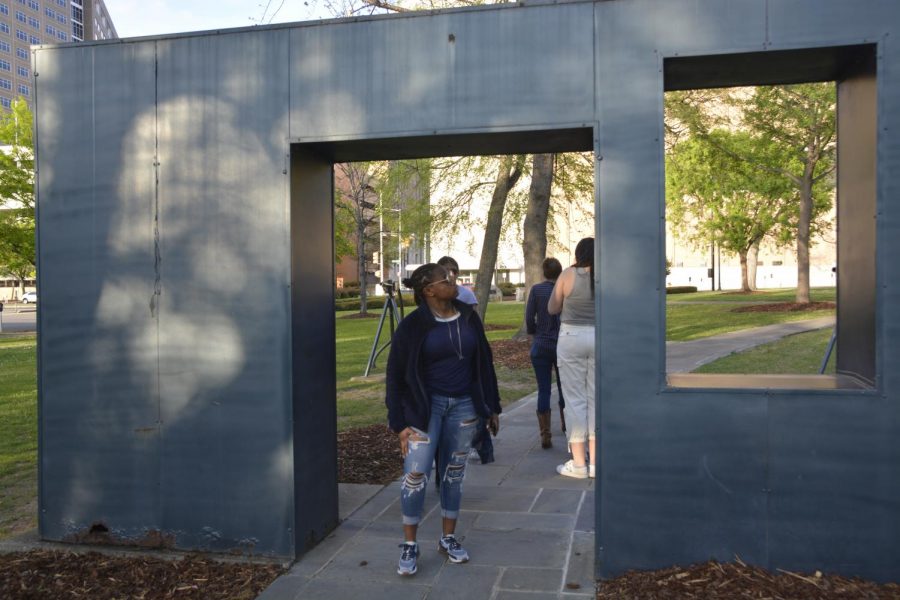United States History Students Travel to the South
More News
Senior Talisha Ward poses under a statue in Kelly Ingram Park in Birmingham, Alabama.
As the lunch crowds rushed towards Commons for a helping of mac and cheese, the 37 students and chaperones on the American South trip gathered their things and headed to the yellow school bus that would take them to their flight to Tennessee for the first leg of their South tour.
After a delay at the airport filled with card games and country music, the group enjoyed a short flight to the Memphis International Airport, and then they moseyed on over to B.B. King Blues Club for dinner and a show.
At B.B. Kings, students and chaperones feasted on authentic Southern baked beans, fried chicken, mac and cheese, and barbecue ribs with a dessert of banana bread pudding. The live music by blues band The King Beez had Poly students on their feet dancing.
Junior Akil Foster said, “B.B. Kings was such a great experience. By dancing in the heart of the South, it took me to a time of unity, community, and justice.”
The next morning, the group traveled to the National Civil Rights Museum, walking through the history of African Americans in the South. The tour culminated in a look at room 306 of the Lorraine Motel, where Reverend Dr. Martin Luther King Jr. spent his last hours. Junior Yashimabet Drummond regarded this museum as her favorite part of the trip.
“It was very moving, and it put me in a very observant and uplifting place,” she said. “I saw the hardships my ancestors had to go through, but it inspired me to not let their hard work go to waste.”
Afterwards, they hopped on a bus manned by the beloved Bill, or “Coach,” to Birmingham, Alabama. There, the group visited Kelly Ingram Park and walked the Civil Rights Heritage Trail before having dinner with University of Alabama Professor Andy Baer. Conversation at dinner revolved around the lasting effects of slavery and the Jim Crow era as well as the importance of children learning this history in school.
The students traveled to Montgomery for the night, where, the next morning, they visited the Equal Justice Initiative Legacy Museum and National Memorial for Peace and Justice.
“I will never forget it,” Foster said. “When you’re there, it feels like you are actually in the time period.”
The building, located in a former slave-holding warehouse, forces the visitor to put themselves in the time of American slavery and the post-Civil War era. The memorial is meant to acknowledge and mourn the lives lost to lynchings. Senior Adonis Brooks believes the memorial did its job.
“The EJI museum and memorial inspired me to work towards change in my community for people who look like me, giving them equal opportunities,” he said.
Junior Madison Malerba said, “The sights that we saw brought forth a lot of hard-to-tackle and thought provoking questions. I appreciated the structure that allowed us to try and address those ideas.”
After the visit, chaperones Margaret Moslander, Michal Hershkovitz, David Reid, and Carmelo Larose led a discussion about the sights students had seen. “I will remember sharing the reflections on the bus about the EJI memorial,” said Moslander. “The most enriching part of the trip was getting to experience all of this history with my students and hearing their questions and experiences.”
The bus ride took the group to Selma, where they listened to Jo Ann Bland recount her experience on Bloody Sunday, the result of Dr. King’s march over the Edmund Pettus Bridge. After, the group walked over the bridge themselves, paying tribute to the Civil Rights marchers who came before them.
They traveled back to Birmingham, and in the morning, attended a Sunday school class at the 16th Street Baptist Church, the location of the 1963 bombing that killed four school-age girls. Following the class, the group made their way back to Memphis for their flight.
Those who went on the trip had the privilege of learning more about the history of slavery and civil rights in our nation, as well as experience Southern culture and food. Now that they are back at Poly, they will hopefully bring the knowledge they gained to our classrooms and share what they have learned with all of the Poly community.

Emily Weinstein ‘20 is the current Online Managing Editor of the Polygon. She began writing for the Polygon at the end of her Freshman year. At Poly,...




























